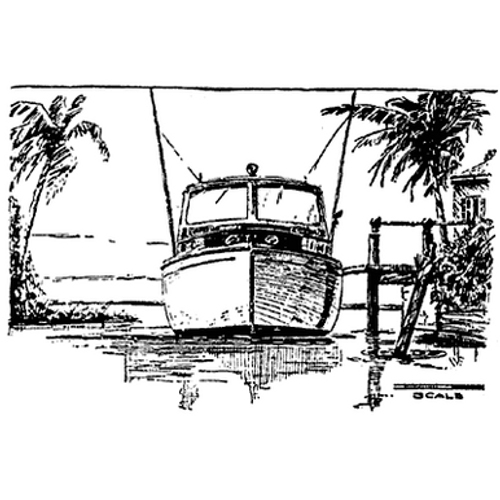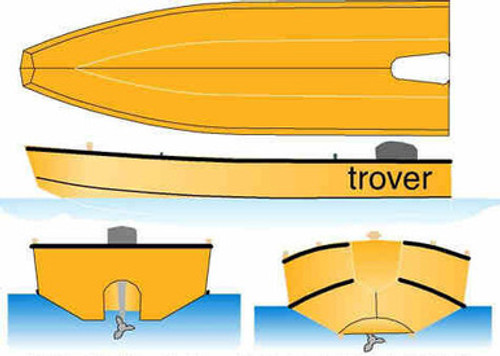"SUN DOG" — 30' Cruiser, wood. Lines of 30' Eico, but a few inches shorter. 9' beam, draft 2' 2". Includes outboard profile, arrangements, lines, offsets, construction plans. 4 sheets and article reprint.
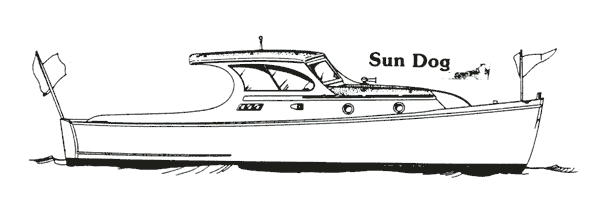
SUN DOG is a fast-gaited, small cruiser of oplinuirn size for three or four-day cruises where you must cover a lot of water. With any of the standard marine power plants like the Gray, Universal, Chris-Craft or Chrysler in the 95 to 105 hp range, she will cruise easily at 14 miles per hour all day, and will top 16 in a pinch. With a Chrysler "Crown," she'll cruise 16 and will do 17 to 19 mph light.
 The feature of minimum sleeping shelter and maximum lavatory, galley and cockpit accommodations has evolved from usage in deep-water fishing, such as is encountered off Miami, the coast of Peru, at Acapulco and Hawaii - all places where boats of almost the same dimensions, built by the famous old Eico Works, Bayonne. N. J., have proven their sterling worth. And thereby hangs the story of Sun Dog's genesis.
The feature of minimum sleeping shelter and maximum lavatory, galley and cockpit accommodations has evolved from usage in deep-water fishing, such as is encountered off Miami, the coast of Peru, at Acapulco and Hawaii - all places where boats of almost the same dimensions, built by the famous old Eico Works, Bayonne. N. J., have proven their sterling worth. And thereby hangs the story of Sun Dog's genesis.
If memory serves me rightly, about 45 cruisers of this type in several series were produced and sold by Elco some 12 to 14 years ago. The original hull was drawn by Bill Fleming, whose wonderful eye for beauty in hulls is second to none. Now, the sea never changes, and when you have a good hull, it always stays good. It was my good fortune to have done designing for this fine old firm, now gone out of the yacht game due to inflation, taxes, labor costs.
Though the type represented by Sun Dog had been superseded by a boat I designed for Elco, the superseding raised-decker of torpedo boat persuasion was based on Bill Fleming's boat, and I got to know his Elcoette like a foster father. I always considered her the happiest strike in boat feel I ever knew.
So when Editor Kesting of SPORTS AFIELD asked me to give him the best cruiser design I could, I came up with Sun Dog. Sun Dog is a few inches smaller, but laid out the same. The hull is mine, as needs be, but the feel will be Fleming-Farmer, and the boat will be always, always good.
Now to physical descriptions:
Sun Dog is 30' 6" long, by 9' beam, and draws 2' 2" light with a Chrysler "Ace" 1.95 lo I reduction gear motor. Rather than install the motor in a protruding box, which is always in the way, a bridge deck covers the motor flush. By using heavy engine floors or bearers, 4" thick and molded to the hull form, and using side stringers, you keep the shaft angle low enough to accommodate a motor of this size neatly under the low bridgedeck.
There is sufficient room, in fact, to install twin screws of as large as Chrysler "Crown" capacity under the bridge, which will give speeds of 22 or 23 mph, setting the hull down about 4" aft and 2" more forward than shown. The freeboard aft at the fishing position is 31" to 33" depending upon load, a very critical dimension for comfort. High-sided boats are murder to work big fish from.
Headroom under the wheelhouse canopy is 6 ft., also the same in the cabin. This has proved ample. The displacement of the boat will be about 9,300 pounds, give or take a few hundred either way. Starting from the stem head on the inboard profile, here are the specs:
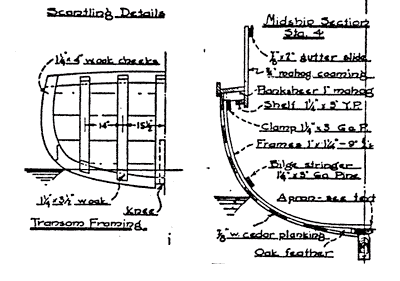
Stem is of 3-3/4" white oak, molded as shown. This is secured to the knee by 1/2" galvanized bolts, or drifts clinched over rings, leaded and bunged. The cark is also heavy, 3-3/4" to give back-rabbet at the turn of the forefoot. It is secured to the knee by 1/2" galvanized fastenings as shown. Pine stopwaters of 3/4" diameter will be placed at water joints.
The keel is 3-3/4" while oak, fayed an shown, under the apron, or keelson, which is of 1-1/4" x 6-1/2" white oak or Georgia pine running from the scarfs at frame 33 back to just forward of frame 13 and temporarily held by screws until installation of the 1-1/8" floors. Abaft frame 13 the horn timber, sided 5" and molded as shown, is rabbeted to perform the keelson function. This horn timber is 3-3/4" wide at the faying surface on the keel, and is swelled immediately to 5" around the shaft hole, which is 1-1/2" diameter to accommodate a 1-1/4" tobin bronze or monel propeller shaft.
Install an oak knee between the transom and frame-floor. No.1, to land the rudder gland on. This rudder gland is of 1-1/4" diameter, swinging a manganese bronze rudder of substantially the shape shown, of an equivalent area provided by a 15" x 15" rectangle. The Columbian Bronze Co. Freeport, L. I., New York, supplies rudder and gland fittings of appropriate size and type. Clevis and rod linkage is used to steering wheel.
The transom is framed around fashion pieces 1-1/4" thick and 3" faced. These are sawn, as is the usual practice, and vertical framing members between fashion piece and deck crown are gained into the fashion piece and crown beam, being of 1-1/4 x 2" white oak. installed on the flat. The transom face is of 7/8" steam bent mahogany, securely fastened over the fashion pieces with 1-1/2" No. 9 Everdur or galvanized screws, bunged with Mahogany plugs.
The transom may also be double planked: Use vertical 1/2" cedar strakes 4" wide between fashion pieces and crown beam, then rivet outer faces of 5/8" steam bent mahogany over this with canvas in bedding compound between. The radius of the transom is 12' 0". The rake is 5". Of course, as any boalbuilder will know the transom must be "expanded" to get proper framing size.
Next comes the framing. This boat is framed with 1" x 1-1/4" white oak, known as green bending oak. About six to ten annular rings to the inch will be about right for coarseness, and the frames are to be laid and sawn, with the grain flat. Spacing is 9" centers. There are a number of ways to land the heel ends of the frames: One is to land the heel about 1" away from the apron, right on the garboard, and side fasten to the floor. Another way which is best, but laborous is to box each heel end into the apron in a mortised gain. The other way is to rim the frame across the apron, and feather between llie garboard and the frame with an oak feather. All are used - I suppose it will be up to you and your usual method to determine this.
The floors are of while oak, 1-1/8" sided, molded to hull shape, depth as shown. These will fasten through the keel with 3/8" or 1/2" galvanized drifts, riveted over clinch rings on the floor top. In the way of the motor compartment all frames are doubled, feathered across the keel, staggered landings on the apron face as full length frames will be hard to steam evenly. The frames in the rest of the ship are to be riveted to the floors.
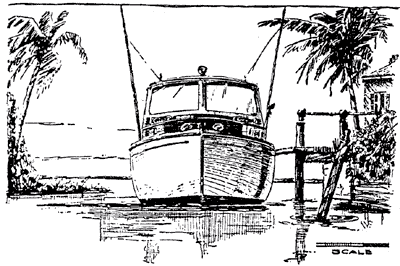
The bilge stringer, top outline of which is shown in the inboard construction profile, is installed after framing and planking, but before putting in the 4" heavy oak floor for motor bearers. This bilge stringer is 1-1/4" x 3" fir, secured to each frame by two staggered 1-3/4" No. 12 galvanized or Everdur screws. The heavy motor bearers are worked up against the skin shape later, using carbon paper to blue out the high spots. These must be carefully filled against skin and frame. They are drifted into the keel by two 1/2" drifts per floor. Normal fastening from plank and floor, of course. Against each heavy floor face 3/16"x3" steel angles are bolted to clamp the 1-3/4" x 5" white oak engine stringers. Metal fishplates may be used in tlie stringer ends to avoid undue fastening loading.
This method of engine mounting has been used much and is resilient, secure. Also it's easy to put in and to change over to other engines without the un-building job sometimes required.
The clamp is of 1-1/4 x 3" Georgia pine, which you can get in long lengths, and will be riveted to frame heads. It will be edge-scarfed in way of engine compartment double frames, approximately a 24" scarf between fi-nines No. 15 and No. 18. Clamp to be installed below sheer edge sufficiently to allow cabin and coaming carlin to come to proper height.
The headers from planksheer edge to cockpit coaming and cabin coaming are 1-1/8" x 2" of yellow pine, with every third one of oak, ash or birch to give better end fastening. The intermediates, to save a little weight, are of the softer wood. A plate of 3/4" x 3", harpin-sawed between cabin bulkhead forward of stanchion 4 and up to stanchion 2 will serve to table the header ends, and might well be left in, though it is not so shown on the plan drawing. Headers are nailed to frame heads with galvanized boat nails, screwed through the molded dimension into the clamp.
The coamings are of 3/4" mahogany, molded as per dimensions on inboard profile. The cabin and wheelhouse sides are of the same material. Crown mold dimensions for the wheelhouse bcams are given. These beams may be sawn, but should be laminated, 1-1/2" sided, 2" molded, of oak or ash, 1/4" laminations, steam-bent and resorcinol glued. Thus, they will hold shape. Sawn, it is doubtful. A combination of sawed-beam with steam-bent and glued mahogany under-laminate might be lasting. A good yard will think nothing of laminating the things. The coach crown for the deckhouse beam is shown in the right hand lay-off, inboard profile, and these beams are also of 1-1/2" sided, 2" molded dimension. The beam landings must be half-gained as the detail shows. Thus they will take down-load. The forward deck beams are sized and spaced as shown.
Since the forward deck of any small vessel takes most of the topside beating, heavy decking is specified. Pine of 7/8" thickness, covered by 1/4" plywood and canvas covered, will handle all the dock-jumping and anchor-tossing you'll ever put the boat to. The coach decking on the cabin is of 13/16" vee-d tongue and groove white pine or cedar for the same reason. A good plan is to lay 1/8" carpet felt over this decking before covering with canvas. The canvas may be stretched in a hot sun or warm, dry room, without bedding in paint as is usual (but prone to crack and peel), and then maybe covered with rubber base paint of buff color to give a deck that will not crack, or leak. Resiliency is a virtue! The method suggested has been well-tried.
Treat the bulkheads as follows: The forepeak bulkhead can be of plywood installed aft of the frame at No. 35, or may be placed between frames No. 34 and No. 35, which would probably be easier. The main cabin bulkhead may be of 1/2" plywood with one face mahogany in the cockpit face. The bulkhead on frame No. 7 is the only watertight bulkhead, rabbeted into the floor and rivited to the frame at the skin of the ship on No. 7. It is of 3/4" plywood, marine grade, in one panel, and is watertight to prevent flooding in case of hull fracture between propeller and driftwood, which can happen, but seldom does, and is thus provided to give integrity to that area which is about the only troublesome point, short of violent grounding.
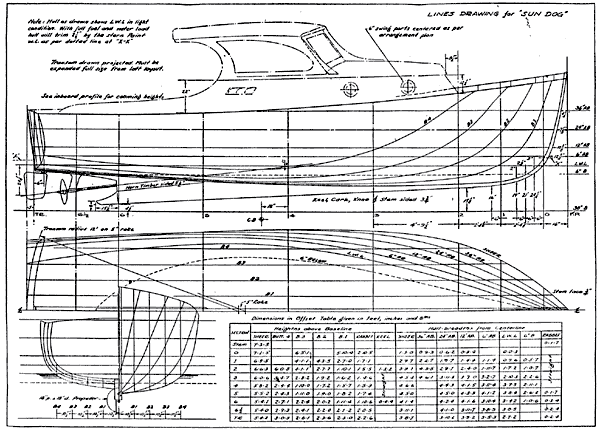
Now we are in the cockpit framing stage. The main headers are of 1-1/2" x 1-3/4" oak-framed for openings as shown. The short headers can be of yellow pine or fir, 3/4" x 2". In way of the bridge, main headers are 2"x2" white oak, because of greater load. The short headers are the same stuff. The landing clamp for the headers along the frames at proper level is of 1-1/4" x 2-1/4" spruce, yellow pine, or similar stuff, screwed to the frames. The cockpit sole may be flat - it's easier - and covered by 3/4" marine grade plywood covered in turn by tan linoleum. Tongue and grooved fir can be used for a roughly finished job. Make it 13/16", and paint it gray. The sole in the way of the bridge should be 3/4"' marine grade plywood, linoleum-covered; 1/2" plywood is too rubbery for a really durable sole. The cabin sole should be of the same stuff, with access hatches cut along in narrow openings along the keel for inspection.
The deckhouse sashes need a word: they are arranged to swing outward, and are framed of 3/4" mahogany. A fashion piece centers along the cabin deck, and against this member the raking sash frames are toe-fastened. Compo sealer should be used all around deck and faying faces.
One word about planking: It is to be of 7/8" mahogany or cedar in narrow strakes, averaging 4" or 5"-no more. It is to be fastened to frames with galvanized boat nails countersunk and clinched, and payed with putty before sanding. To be planed to 13/16" thickness approximately, and in no case to be less than 3/4" finished. Construction thus is of medium weight, - not light, not heavy, and amply strong to give Sun Dog the clean-heeled running ability which is her forte.
The covering board is to be of mahogany, 3/4" thick. The bulwark is of the same material and is screwed and bunged along the covering board and lop edge of sheer plank, For hardware: The usual white light forward, flanked by red to port and green to starboard, and a white range light atop the wheelhouse will be required by law. The galley is to be provided with a small sink, and with a faucet pump connected by copper tube and nippled hose connections to the 30-gallon water tank under the cockpit. A tee will carry water to the lavatory basin. A simple Wilcox Crittenden Cadet water closet will be installed.
Copper gasoline tanks must be dummied up to fit the skin of the frames, and will run in depth as shown on the inboard profile. One tank is to port, the other to starboard. They hold 80 gallons of fuel between them. The tanks are cross connected, with independent valves which will usually be left open for common feeding, but which may be fed independently to the main line.
The engine shown on the construction plan is the Chrysler "Ace." An even longer engine can be used - the Chrysler "Crown." if two smaller engines, such as the Chris-Graft model B, 60 hp are wanted, use reduction gears also, but shorten the engine space by installing the forward heavy bearer on frame 20. This will give spacing shown on arrangement plan. Both arrangement plan and inboard construction profile agree in cabin length, galley length, berth length. But with shorter engines, the bulkhead in the cockpit can be brought back one frame. Rather than make two separate inboard profiles for this slight change I have indicated it as described.
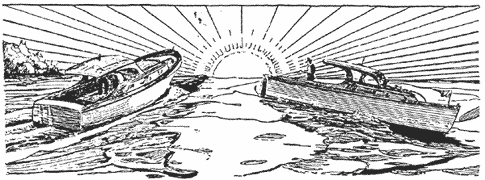
All engine controls are led to a control column box on which the instrument panel is located. To port of the controls hangs a compass on gimbals. The problem of ventilating the engine compartment is handled by port and starboard duct boxes framed out as shown, and covered with 3/8" mahogany faced plywood. The exhaust pipe leads from a Thermex Silencer into rubber steam hose nipples, thence through the transon in approved fashion.
A fighting chair may be installed in the cockpit by the addition of a large pad, and appropriate stanchions between headers and floors. Outrigging equipment is available at most marine supply stores. And with the addition of bait tank in the lazarette under the aft deck, and by adding a roller astern for boating the big ones, you have a perfectly suited fishing boat of the time-tried variety.
This is not a boat to be tackled by the beginner. The plans given are unusually complete from the standpoint of a yacht yard. Probably the best bet would be for the prospective owner of Sun Dog to get the hull built by a good small yard, and finish her off yourself. This arrangement has been highly satisfactory in a number of cases. The yard does the work it can do rapidly which you cannot do; then you do the money saving joinery, which runs the cost up in a boat yard.
Take her away, Skipper!

